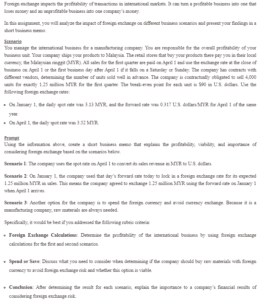Foreign Exchange Memo
To: Manufacturing Company
From: ManaWe’llf International Business
Subject: Significance, viability, and profitability of considering foreign exchange
Greetings
Regarding my duty as a manager, my responsibility is to ensure the overall profitability of the business. Accordingly, below is the assessment of three scenarios clarifying profitability, viability, and the significance of considering foreign exchange.
Scenario 1
Spot rate on 1st April = 3.52 MYR, units sold = 4,000, units equivalent = 1.25 MYR
| Amount per unit
|
MYR 1,250,000 ÷ 4000 =MYR 312.5 per unit |
| Exchange rate from MYR to USD
|
MYR 312.5 ÷ MYR3.52 = USD 88.78
|
| Profit per unit USD | USD 90 – USD 88.78 = USD 1.22 |
| Contractual profit | USD 1.22 × 4,000 units = USD 4,888 |
Scenario 2
| Forward Rate | 0.317 = 1/USD 0.317 = MYR 3.15 |
| Difference in rate | MYR FUTURE RATE 3.15 –MYR Spot rate 3.13 = MYR 0.02 |
| Amount Per Unit | MYR 1,250,000/4,000 UNITS = MYR 312.5 per unit |
| Exchange rate from MYR to USD | Unit 312.5 ÷ MYR 3.15 = USD 99.206 |
| Loss per Unit USD | 90 – USD 99.206 = (USD 9.206) |
| Contractual Loss | USD (9.206) × 4,000 units = USD (36,824) |
Scenario 3
Scenario 3 attempts to avoid foreign exchange risk. According to Zhu & Sardana (2020), currency exchange rate fluctuations are risks arising from foreign exchange. Notably, trade deals and inflation can result in non-fixed currencies between countries (Lewis & Bozos, 2019). For the subject case, the company could consider utilizing a foreign banking system to escape the adverse effects of currency exchange. Also, the company can consider purchasing raw materials using MYR, which can help make a profit by mitigating exchange risk.
Conclusion
A comparison between the three scenarios considers the first scenario the best option. Scenario 3 is available for selection because it allows our company to mitigate the foreign exchange risk. Scenario 2 is undesirable because it would put our company in a loss-making position. However, it helps us understand the point beyond which we will make a loss to be at MYR 3.48. Thus, scenario one is perceived as the best.
References
Lewis, Y., & Bozos, K. (2019). Mitigating post-acquisition risk: The interplay of cross-border uncertainties. Journal of World Business, 54(5), 100996.
Zhu, Y., & Sardana, D. (2020). Multinational enterprises’ risk mitigation strategies in emerging markets: A political coalition perspective. Journal of World Business, 55(2), 101044.
ORDER A PLAGIARISM-FREE PAPER HERE
We’ll write everything from scratch
Question
Foreign exchange impacts the profitability of transactions in international markets. It can turn a profitable business into one that loses money and an unprofitable business into one company’s money.

Foreign Exchange Memo
In this assignment, you will analyze the impact of foreign exchange on different business scenarios and present your findings in a short business memo.
Scenario
You manage the international business for a manufacturing company. You are responsible for the overall profitability of your business unit. Your company ships your products to Malaysia. The retail stores that buy your products there pay you in their local currency, the Malaysian ringgit (MYR). All sales for the first quarter are paid on April 1 and use the exchange rate at the close of business on April 1 or the first business day after April 1 if it falls on a Saturday or Sunday. The company has contracts with different vendors, determining the number of units sold well in advance. The company is contractually obligated to sell 4,000 units for exactly 1.25 million MYR for the first quarter. The break-even point for each unit is $90 in U.S. dollars. Use the following foreign exchange rates:
- On January 1, the daily spot rate was 3.13 MYR, and the forward rate was 0.317 U.S. dollars/MYR for April 1 of the same year.
- On April 1, the daily spot rate was 3.52 MYR.
Prompt
Using the information above, create a short business memo that explains the profitability, viability, and importance of considering foreign exchange based on the scenarios below.
Scenario 1: The company uses the spot rate on April 1 to convert its sales revenue in MYR to U.S. dollars.
Scenario 2: On January 1, the company used that day’s forward rate today to lock in a foreign exchange rate for its expected 1.25 million MYR in sales. This means the company agreed to exchange 1.25 million MYR using the forward rate on January 1 when April 1 arrives.
Scenario 3: Another option for the company is to spend the foreign currency and avoid currency exchange. Because it is a manufacturing company, raw materials are always needed.
Specifically, it would be best if you addressed the following rubric criteria:
- Foreign Exchange Calculations: Determine the profitability of the international business by using foreign exchange calculations for the first and second scenarios.
- Spend or Save: Discuss what you need to consider when determining if the company should buy raw materials with foreign currency to avoid foreign exchange risk and whether this option is viable.
- Conclusion: After determining the result for each scenario, explain the importance to a company’s financial results of considering foreign exchange risk.

